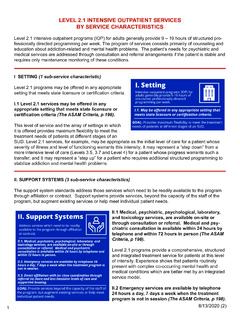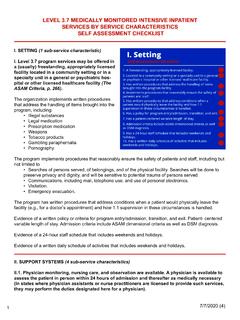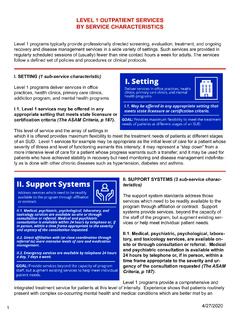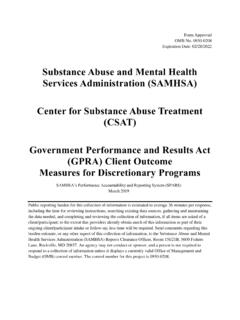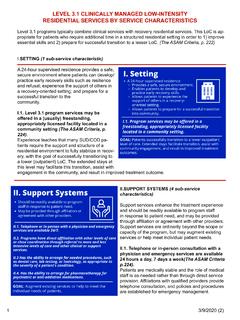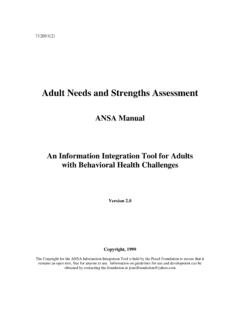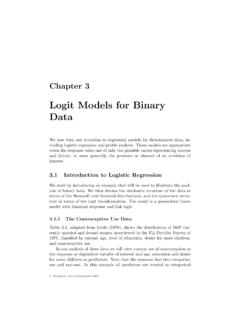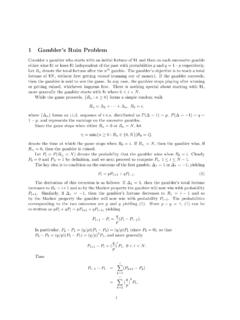Transcription of July 1, 2020 – June 30, 2025
1 July 1, 2020 June 30, 2025. Effective 7-1-2020. Revised 7-29-2021. CASE MANAGEMENT AND CLINICAL SERVICES MANUAL. Table Of Contents Part I: General Information .. Purpose and Use of the Manual .. Part II: SCA Needs Assessment and SCA Needs Assessment and Plan .. Part III: Special Populations .. Priority Populations .. - Pregnant Women .. - Persons Who Inject Drugs (PWID) .. - Women with Children .. - Overdose Survivors .. - Part IV: Service Continuum .. - Continuum of - Halfway House - Emergency Housing - Recovery Housing .. - Medication Assisted Treatment (MAT) .. Part V: Case - Case Management Overview .. - Screening .. - Assessment and Placement - Referral and Admission to - Communicable Disease Screening and Referral Services.
2 - Coordination of Services .. - WITS Case Management Requirements .. - Supervision .. - Staffing - Core - Grievance and Appeal Process .. - Reporting .. - Confidentiality of Information .. Part VI: Recovery Support -Recovery Support Services .. Part VII: Culturally and Linguistically Appropriate Services .. Culturally and Linguistically Appropriate Services (CLAS) .. Part VIII: - Miscellaneous .. Part IX: Contingency Management .. - Contingency Management .. Appendix A: Appendix B: Glossary .. Part I - General Information PART I: GENERAL INFORMATION. Purpose and Use of the Manual The mission of the Department of Drug and Alcohol Programs (DDAP) is to engage, coordinate and lead the Commonwealth of Pennsylvania's effort to prevent and reduce substance use disorders (SUD) and to promote recovery, thereby reducing the human and economic impact of the disease.
3 This work is carried out in conjunction with the Single County Authorities (SCAs), their contracted providers, and the community at large. The SCAs have flexibility to develop their service delivery system in response to community needs. DDAP has developed the Case Management and Clinical Services Manual (CMCSM) to comply with and convey the requirements of the Substance Abuse Block Grant (SABG) and 4 Pa. Code The CMCSM sets forth requirements for SCAs and their contracted providers in delivering services to individuals with SUD and their families. The SCA Grant Agreement takes precedence over the Prevention, Case Management/Clinical Services, Fiscal and Operations Manuals issued by DDAP, unless otherwise specified by DDAP or the Commonwealth, such as in Policy Bulletins or Management Directives.
4 In addition, it may be necessary to issue temporary instructions, which will take precedence over material in this Manual. Any temporary instructions will clearly state the exception and include an expiration date. CMCS Manual July 2020 Part II - SCA Needs Assessment and Plan PART II: SCA NEEDS ASSESSMENT AND PLAN. SCA Needs Assessment and Plan To adequately plan for services most needed, SCAs must complete a Needs Assessment in order to identify any demographic changes that must be considered, current service use, including capacity and access issues, and any other areas of concern, gaps or needs that should be addressed. The SCA Needs Assessment and subsequent Plan provide the opportunity for SCAs to present information to DDAP on how the SCA is providing services related to SUD in the most efficient and effective manner and at the most appropriate level of care to individuals in need of services.
5 The information provided by the SCAs will significantly contribute to DDAP's ability to detect patterns of unmet need and provide a strategic insight to improve the service delivery system. SCAs are different in their geography, economics, population demographics, and density. Substance use trends and vulnerable populations change over time and across communities. These changes impact prevalence, incidence, and treatment demand estimates, which SCAs can use to match available resources with projected demand and plan for the development of new resources based upon needs. The Needs Assessment is a process through which the SCA uses reliable data to estimate the prevalence of SUD for people in its area.
6 The Needs Assessment further identifies emerging SUD trends that may impact demand for treatment and services, methods to address SUD, and potential barriers to providing effective treatment and services. The SCA should apply the information gathered, compiled, and analyzed through the Needs Assessment process to the development of the SCA Plan for the Delivery of Treatment &. Services (SCA Plan). The SCA Plan is designed to assist SCAs in defining needs and developing the resources necessary to meet those needs. The SCA Plan must: A. Describe trends and issues that were identified through the needs assessment process and how they will be addressed;. B. Address outcomes separately with a plan of action to meet each objective.
7 C. Describe the steps used for developing the plan, including the process for stakeholder input;. D. Describe the fiscal impact of each plan of action and how the SCA will allocate funding to meet the need;. E. Describe the SCA's quality management initiatives; and F. Describe the manner through which individuals access services. The SCA Needs Assessment and Plan must be completed and submitted according to the DDAP Report Schedule, and in accordance with the directions and any accompanying documents provided by DDAP. CMCS Manual July 2020 Part III - Special Populations PART III: SPECIAL POPULATIONS. Priority Populations A. The SCA and its contracted providers who serve an injection substance use population and who receive SABG funds shall give preference to treatment as follows in the order outlined below.
8 1) Pregnant women who inject drugs 2) Pregnant women who use substances 3) Persons who inject drugs 4) Overdose survivors 5) Veterans B. All individuals in these priority populations must have a level of care assessment (LOCA) and be offered admission into the recommended level of care. If the SCA or contracted provider cannot ensure admission to the recommended level of care immediately, the individual must be offered case management services as well as admission to another level of care. Any individuals in need of emergency care should be treated as outlined in Section C. An SCA may not restrict access to admissions to treatment for priority populations even if it applies restriction to others.
9 Pregnant Women Both the SABG and CMCSM identify pregnant women who inject drugs and pregnant women who use substances as priority populations. The SCA and its contracted providers must adhere to the following steps: A. Screen the woman for emergent care needs. 1) If emergent care needs are identified, make an immediate referral to the appropriate service. B. If no emergent care needs are identified and a LOCA is necessary, then conduct a LOCA. to determine the need for treatment. C. If treatment is indicated, refer the woman to a treatment provider that has the capacity to provide treatment services to the woman immediately. DDAP has provisions for narcotic treatment programs (NTP) that are at capacity but need to admit a pregnant woman for treatment of an opioid use disorder (OUD).
10 DDAP's Division of Program Licensure will review exception requests to increase capacity for any NTP on a case-by-case basis. In the event this is necessary, contact DDAP's Division of Program Licensure at 717-783-8200. 1) If no treatment facility has the capacity to admit the woman immediately, then;. (a) Make support services such as case management or recovery support services available within 48 hours after the LOCA, and CMCS Manual July 2020 Part III - Special Populations (b) Make interim services available to the woman within 48 hours after the LOCA. 2) Interim Services are defined as services that are provided until an individual is admitted to a substance use treatment program.

